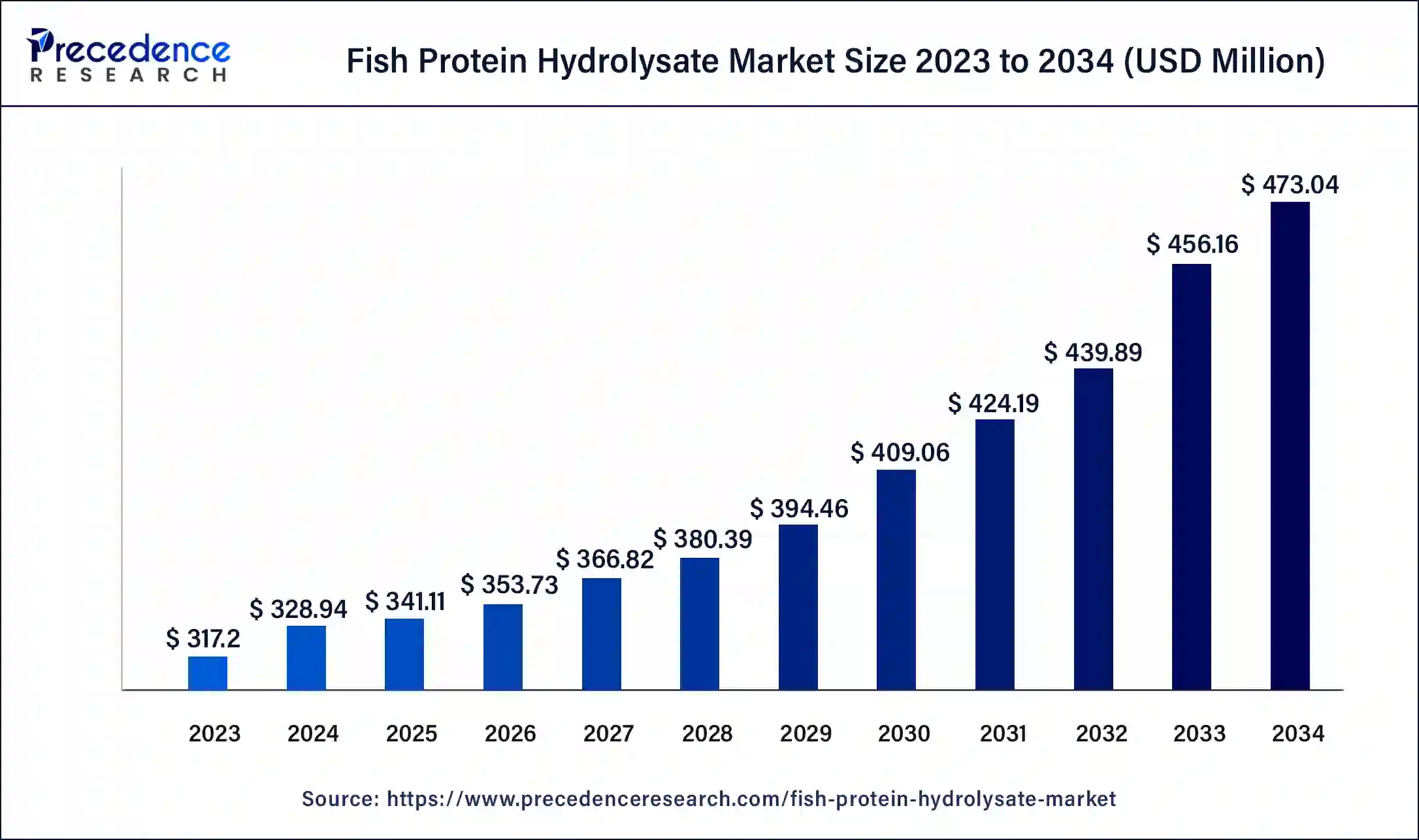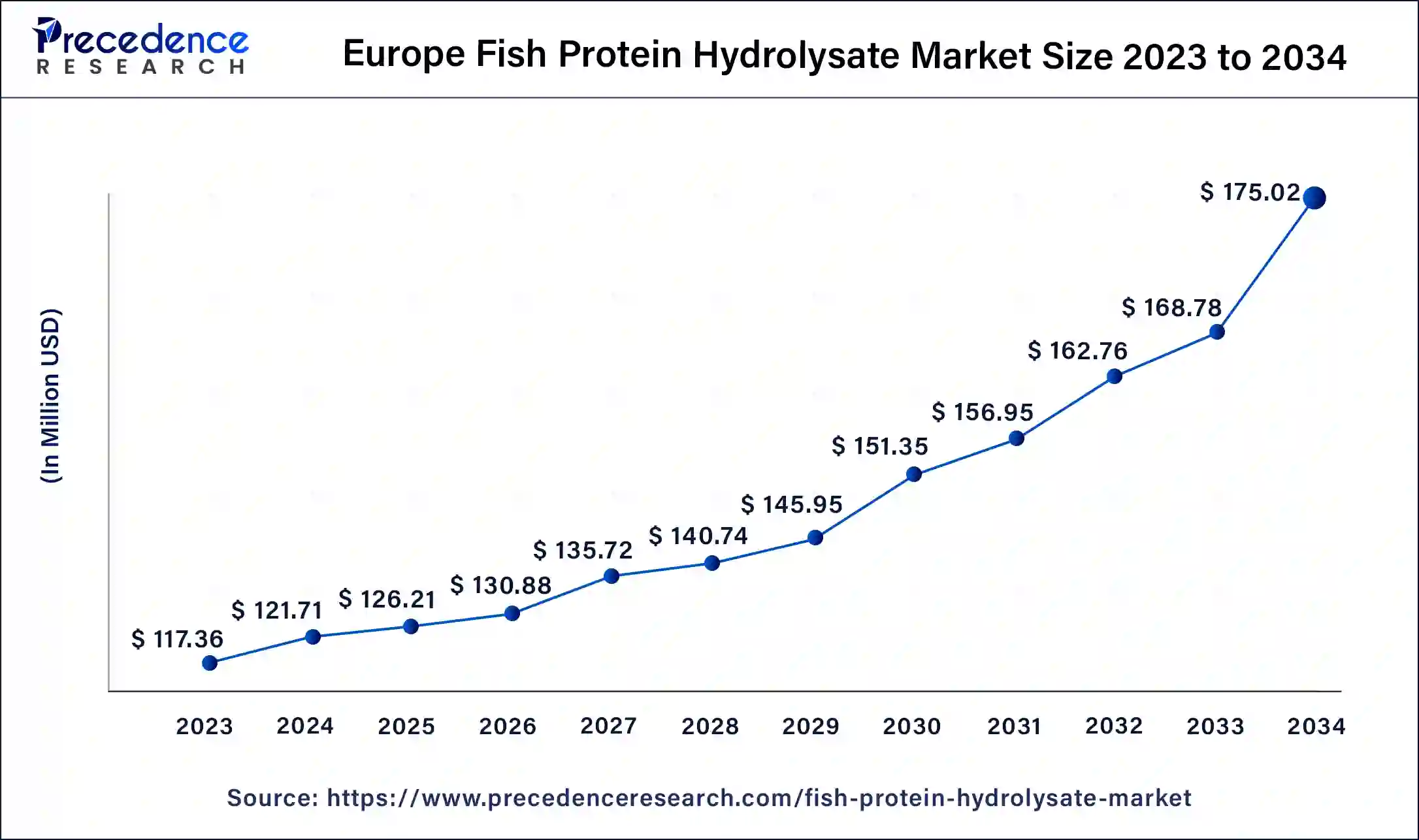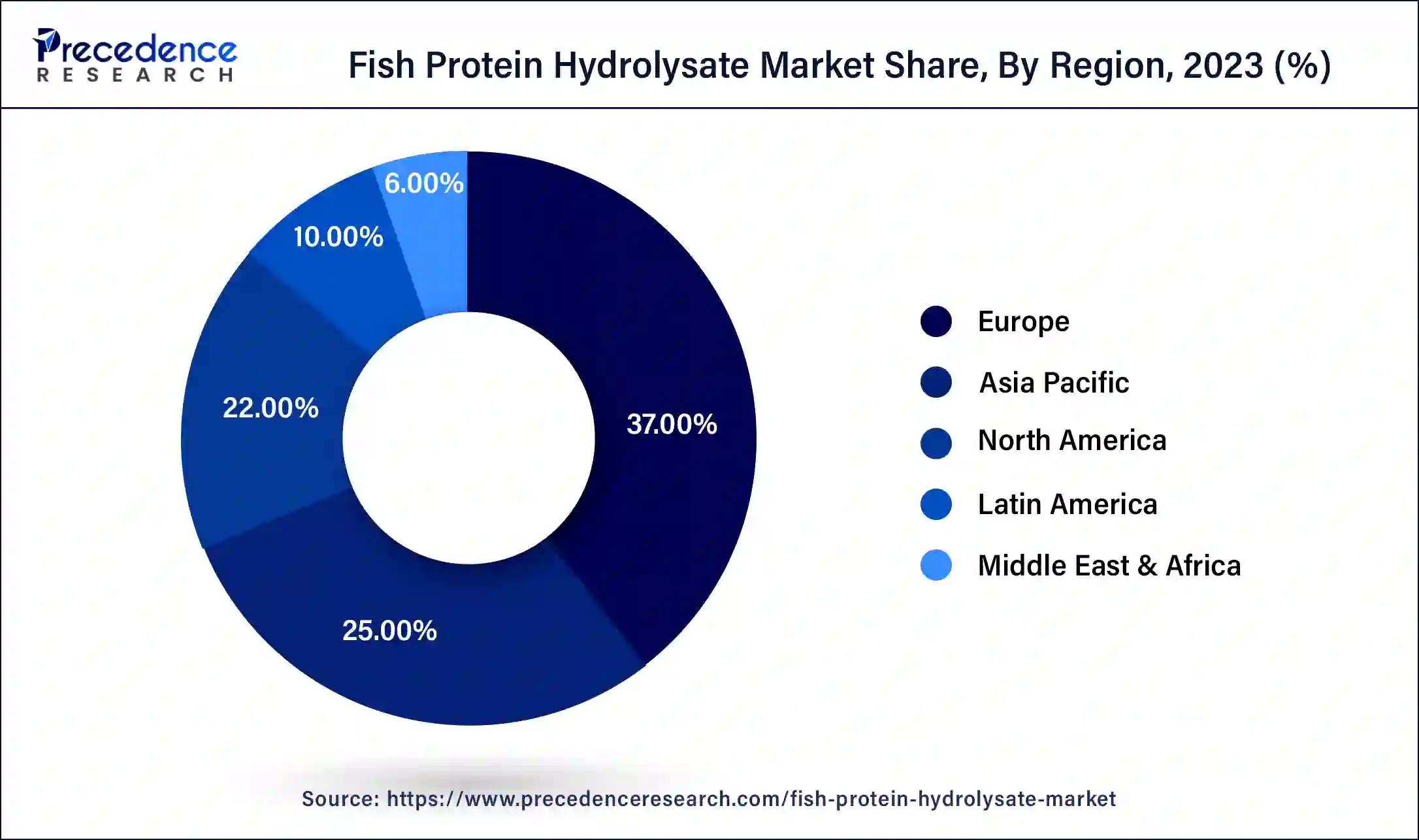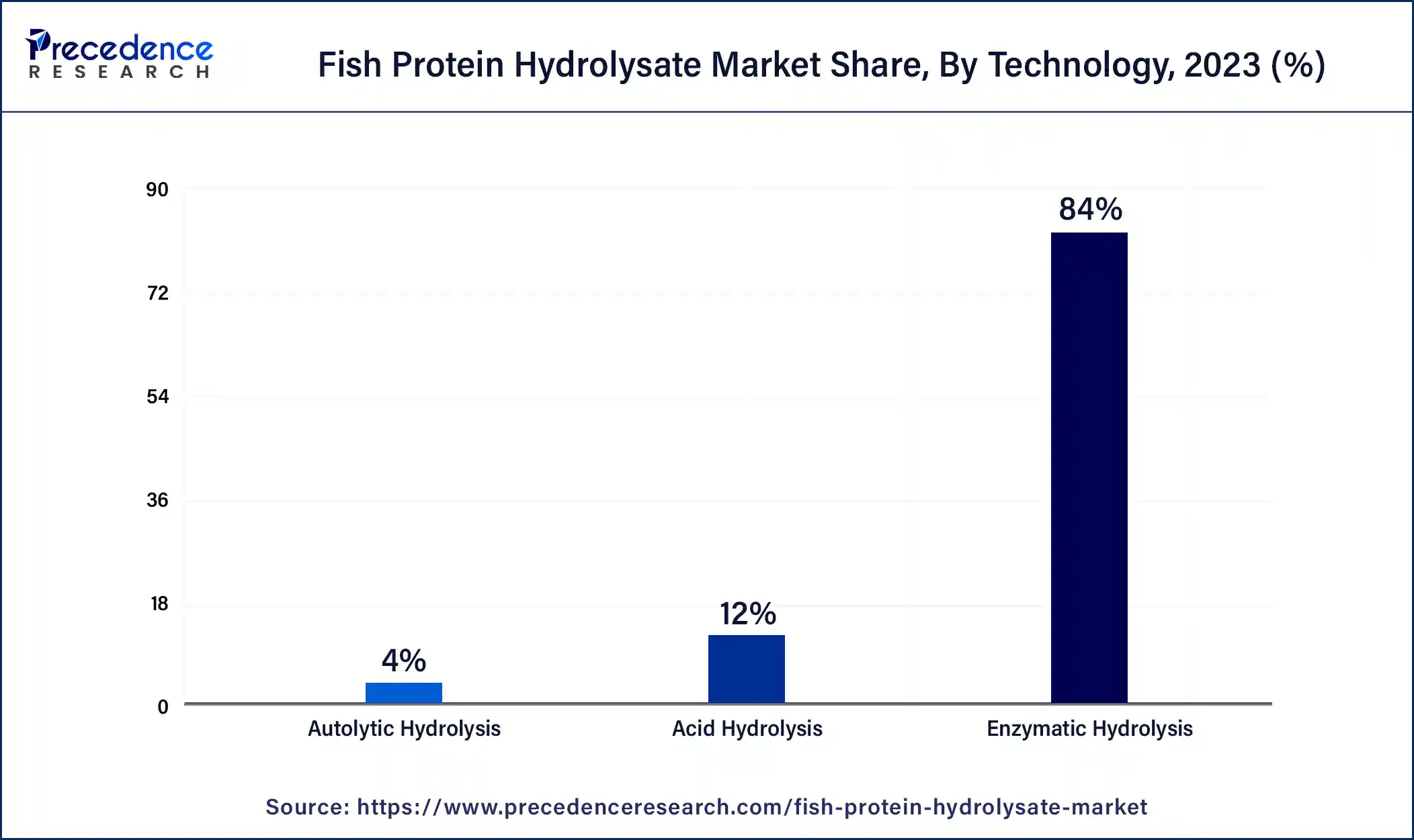September 2024
Fish Protein Hydrolysate Market (By Form: Powder, Paste, Liquid; By Technology: Acid Hydrolysis, Enzymatic Hydrolysis, Autolytic Hydrolysis; By Source: Tuna, Anchovy, Tilapia, Sardine, Atlantic salmon, Crustacean, Molluscs, Codfish, Others; By Application: Pharmaceuticals, Food Industries, Animal Feed Industries, Agriculture, Others) - Global Industry Analysis, Size, Share, Growth, Trends, Regional Outlook, and Forecast 2024-2034
The global fish protein hydrolysate market size was USD 317.20 million in 2023, accounted for USD 328.94 million in 2024, and is expected to reach around USD 473.04 million by 2034, expanding at a CAGR of 3.3% from 2024 to 2034. Consumers rising awareness for nutrient-rich food supplements with chemical free and low toxicity for animal and pet feed is bolstering the demand for fish protein hydrolysate and helps in the market's growth on a global level.

The Europe fish protein hydrolysate market size was estimated at USD 117.36 million in 2023 and is predicted to be worth around USD 175.02 million by 2034, at a CAGR of 3.5% from 2024 to 2034.

Europe's fish protein hydrolysate market is expected to grow at a notable rate during the forecast period. the trend of humanization of pets is increasing, and many people have their own pets in the house, and they treat them as a part of the family. This trend is primarily observed in European countries. Fish protein hydrolysate is, therefore, widely used in animal feed and pet food products. It can enhance animals' digestive processes and improve their overall health. As a result, it is commonly used in animal feed products, including premium pet food.

Asia Pacific region is expected to experience substantial growth due to the increasing livestock and rising number of pet owners, which are likely to increase demand for the fish protein hydrolysate market. Besides, fishing activities in countries like India, Japan, China, and Indonesia are rapidly growing and thus fuelling the growth of the market. The key players in the Asia Pacific region are engaging in improving methods to achieve better fish protein hydrolysate that helps in easy digestibility, propelling the growth of the Asia Pacific market on a global level. Pet owners are becoming more conscious of choosing food products that fulfill the nutritional requirement of the pet for healthy animal growth, which is expected to augment trends in the fish protein hydrolysate market.
North America is the most significant region for the market owing to the rising demand for nutraceuticals and various cosmetics in countries such as the United States. These people use more collagen-enriched cosmetics for their personal care, which helps anti-aging. Moreover, well-established cosmetic manufacturers are updating their reach and portfolio by adding collagen content to beauty products and made available to consumers. Such efforts by manufacturers and rising cosmetic demand for a youthful glow fuelled the fish protein hydrolysate market's growth.
Consumer awareness for high protein diet to their pets and animals have been increased in recent years is likely to boost the expansion of the fish protein hydrolysate market. The European union has banned a mammalian meat and bone meal protein for the animal feeding use. This may shift the consumers focus on the fish protein uses for animal feed which gives them maximum health benefits. Fish protein is powerhouse for amino acids and other vital nutrients that are essential for healthy growth of pets and animals. The presence of essential nutrients is expected increase demand for fish protein hydrolysate market.
Additionally, processes are becoming more innovative to produce the protein hydrolysate which in turn raises a yield with less time and fewer cost may positively change industry's outlook. Liquid fish protein hydrolysate is easier for absorption in intestine of animals. These products act as a nutritional dose and help in boosting the digestive system with reducing risk of bacterial and viral infections and thereby increase feasibility of metabolic system in animals and pets. Manufacturers are constantly looking for innovative solutions to adopt a technique to derive natural protein sources in animal feeds products so that to improve quality of derived products.
| Report Coverage | Details |
| Global Market Size in 2023 | USD 317.20 Million |
| Global Market Size in 2024 | USD 328.43 Million |
| Global Market Size by 2034 | USD 473.04 Million |
| Growth Rate from 2024 to 2034 | CAGR of 3.54% |
| Largest Market | Europe |
| Base Year | 2023 |
| Forecast Period | 2024 to 2034 |
| Segments Covered | By Form, By Technology, By Source, and By Application |
| Regions Covered | North America, Europe, Asia-Pacific, Latin America, and Middle East & Africa |
Wide use of fish protein hydrolysate for animal feed
Fish protein hydrolysate is widely used in animal feed products owing to their property to fight against infectious diseases caused by metabolic disturbances in animals and pets. They provide high nutritional value for animals' health. For instance, broiler chickens highly benefit from fish protein hydrolysate consumption as it aids in the development of muscles, and flesh-to-bone density is also gained by using a fish protein product. Enzymes in fish proteins assist in the digestion of fiber-rich food such as multigrain and soybean meal for the animals.
Fiber-rich foods are healthy for producing gut bacteria in the intestines of animals, leading to the greater absorption of nutrients in the food and ease of digestion. Due to this, the demand for natural growth facilitators is increasing compared to antibiotic promoters, as antibiotic promoters have the property of bioaccumulation. These are the significant factors that are driving the fish protein hydrolysate market on a global level.
Scarcity of quality raw materials
The scarcity of raw materials like Atlantic salmon may hamper the fish protein hydrolysate market growth. Atlantic salmon are found on the shores of Scandinavian countries like Norway, Sweden, Denmark, etc. High-quality fish like tuna are sourced from the Sea of Japan. Such high-quality fresh fish are hard to get, and moreover, they are highly biodegradable in nature, making them delicate to store and handle. It needed to be stored, processed, and sold as quickly as possible to restrain its possibility of spoilage. The blockages in transportation and obstructive routes for the fresh food supply chain may hinder the expansion of the market res, resulting in the lowering of the growth of the market on a global level.
Widely used applications in the cosmetic and personal care industry
Fish protein hydrolysate has rich amino acids with bioactive properties, making it a flawless ingredient for skincare and haircare regimens. The cosmetic industry is progressively recognizing the potential of fish protein hydrolysate to rejuvenate and improve the texture of skin and hair. Fish protein's bioactive peptides help moisturize skin by reducing signs of aging and escalating collagen production for complete skin health. These properties have led to combining fish protein hydrolysate into various cosmetics such as creams, hair serums, skin and hair masks, and shampoos with conditioner. Consumers are increasingly seeking organic-based and sustainable options in their personal skin and hair care products. Fish protein hydrolysate is eco-friendly and ethically sourced, often derived from fishery by-products. Such collaboration with consumer preferences, with practical and scientifically proven cosmetic solutions in the personal care industry, is a robust driver for the fish protein hydrolysate market's expansion, which creates further opportunities for manufacturers and consumers as well.
The fish protein hydrolysate market is segmented into powder, liquid and paste forms. Among these, powder solutions are mostly used in the manufacturing of pharmaceutical-grade protein powders and thus, this segment dominated the global market. These protein powders are economically reasonable as compared to whey protein powders. Also, low toxicity nature makes them highly beneficial which is likely to foster the protein powder segment in the market, it also has less chance of spoilage and easy to store. These products contain excellent amino acid with high solubility in water making them more suitable for pharmaceutical and nutraceutical formulations.
Based on technology, fish protein hydrolysate market is divided into acid hydrolysis, enzymatic hydrolysis, autolytic hydrolysis. Among these, enzymatic hydrolysis segment dominates the market. Increasing demand for low contamination and lower concentrations of heavy metals will likely boost segment’s growth. Enzymatic hydrolysis process has ability to retain valuable nutrients and neutral taste with shortening the reaction time for the process.
Owing to the retention of essential nutrients, enzymatic hydrolysis process is most popular in the market. Enzymatic hydrolysis is an advanced and precise method that depends on the use of specific enzymes to break down the complex protein structures found in fish and convert them into relatively more minor peptides and amino acids.

This process provides several advantages over conventional methods. It allows for the customizable production of fish protein hydrolysate with expected properties, including the size of peptides, nutritional profile, and bioactivity. This level of control is crucial for fabricating fish protein hydrolysate to meet the diverse necessities of various industries such as the food industry, nutraceuticals and pharmaceutical industry, and cosmetics industry.
Additionally, enzymatic hydrolysis is a milder process than chemical or thermally processed methods, which can degrade proteins and hamper the quality and bioactivity of the produced fish protein hydrolysate. Enzymes work best under specific temperature and pH conditions to preserve the quality of the protein structure and bioactive components.
Based on a source, fish protein hydrolysate market is further subdivided into tilapia, tuna, atlantic salmon, cold fish, crustacean, anchovy and molluscs. The Atlantic salmon segment is observed to witness notable rate of growth in the market. Atlantic salmon are rich in protein than others. They have higher contained of omega-3 fatty acids with long tale of amino acids which is require for several aquacultures' compatibility with salt and sea water is likely to foster this segment in the fish protein hydrolysate market. Industry players are rapidly introducing innovative products for pure Atlantic salmon hydrolysates owing to its high-quality protein and it helps in reducing outbreak of various infections. It is also able to improvs flesh to bone density in fish which is likely to increase its demand in the global market.
The market is dominated by the animal feed industries segment. The growth of contagious diseases in livestock, has increased the use of supplemental feed additives to increase the immunity of the livestock such as cow, Cattell etc. The demand for foods derived from animals to boost the amount of protein in diets also fuel the market for animal feed supplements. It aids in enhancing feed effectiveness, which increases amount of milk, meat, and egg production, quality for human consumption that promote industrial expansion on a global scale.
The pharmaceuticals segment is observed to grow at a significant rate in the fish protein hydrolysate market during the forecast period. Fish protein hydrolysate is rich in essential amino acids, vitamins, and minerals, making it an ideal nutritional supplement for individuals with specific dietary requirements or nutritional deficiencies. Pharmaceutical companies are formulating dietary supplements and medical foods containing fish protein hydrolysate to address nutritional gaps and support overall health and well-being. These products are particularly relevant for populations with special nutritional needs, such as infants, elderly individuals, athletes, and patients recovering from illness or surgery.
Segments Covered in the Report
By Form
By Technology
By Source
By Application
By Geography
For inquiries regarding discounts, bulk purchases, or customization requests, please contact us at sales@precedenceresearch.com
No cookie-cutter, only authentic analysis – take the 1st step to become a Precedence Research client
September 2024
April 2025
December 2024
February 2025